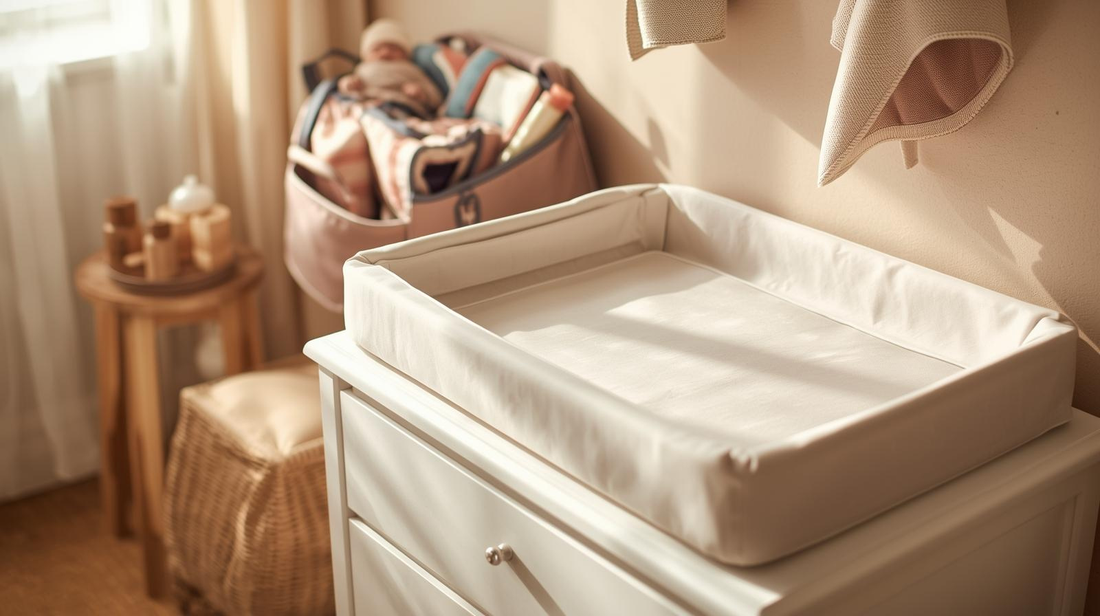
The Ultimate Guide to Non-Toxic Portable Changing Pads: What to Look For and What to Avoid
Share
As a parent, your baby's health and safety are your top priorities. While a portable changing pad is a diaper bag essential, not all are created equal. Understanding the materials and certifications behind a "non-toxic" label is crucial for protecting your little one from harmful chemicals. This guide will empower you to make an informed, safe choice for your baby.
Why a Non-Toxic Changing Pad Matters for Your Baby's Health
Your baby's first line of defense—their skin—is incredibly delicate and more absorbent than adult skin. This means chemicals from surfaces they touch can be more easily ingested. Additionally, their respiratory systems are still developing, making them vulnerable to airborne toxins.
Understanding Baby's Delicate System
Newborns and infants have a higher surface-area-to-volume ratio, which allows substances to penetrate their skin more readily. This makes them particularly susceptible to the effects of synthetic chemicals found in some products.
The Risks of Common Toxins in Baby Products
Many conventional products contain chemicals like phthalates (used to soften plastic, linked to hormonal disruption), lead (a neurotoxin), and BPA (linked to developmental issues). These are especially concerning in items that come into direct, prolonged contact with your baby's skin.
How to Define "Non-Toxic" in Baby Items?
"Non-toxic" can be a vague marketing term. The most reliable way to verify safety is to look for independent, third-party certifications.
Key Certifications to Trust
-
GREENGUARD Gold: This is the gold standard for low chemical emissions. It certifies that a product meets some of the world's most stringent standards for volatile organic compounds (VOCs), ensuring the air your baby breathes during changes is cleaner.
-
OEKO-TEX Standard 100: This certification tests every component of a textile product—from fabric to thread—for a list of over 100 harmful regulated and unregulated substances, giving you confidence in the material itself.
Reading the Label: What "Free Of" Really Means
Look for explicit claims like "PVC-Free," "Phthalate-Free," "BPA-Free," and "Lead-Free." While these are a good starting point, they are most trustworthy when backed by the certifications above.
Change Pad Materials Decoded: PVC, PU, TPU, and PE
The material is the heart of your changing pad's safety. Here’s a breakdown of what you’ll find.
PVC (Polyvinyl Chloride): Why It's a Red Flag
Often labeled simply as "vinyl," PVC is a material to avoid. To make it flexible, it often requires phthalates. It can also contain heavy metals like lead and may emit harmful VOCs. Its production and disposal create dangerous byproducts like dioxins.
PU (Polyurethane) Leather: A Popular and Safer Alternative
PU leather is a common and much safer choice. It is a synthetic leather that does not contain chlorine (unlike PVC), and high-quality, water-based PU options have low VOC emissions. It provides a soft, wipeable surface without the major toxic concerns.
TPU (Thermoplastic Polyurethane): The High-Performance Winner
TPU is a step above PU, offering superior elasticity, durability, and waterproofing. It is inherently free of BPA, phthalates, and PVC. Many premium, eco-conscious brands choose TPU for its excellent safety profile and performance.
What About Polyethylene (PE) Covered Change Pads?
Polyethylene is a food-grade, BPA-free plastic commonly used in food storage and medical devices. Changing pads with a PE surface are typically rigid and are a very safe, non-toxic option. The primary trade-off is that they may be less cushioned than their TPU or PU counterparts.
Your Checklist: What to Look for in a Non-Toxic Portable Changing Pad
Use this quick list on your shopping journey.
Priority #1: Material Composition
Your ideal choice, in order of preference: TPU > High-Quality PU > Food-Grade PE > GOTS-Certified Organic Cotton. Steer clear of PVC/Vinyl.
Priority #2: Independent Certifications
Look for the GREENGUARD Gold or OEKO-TEX Standard 100 logos. These provide the highest assurance of a product's safety claims.
Bonus Features for Convenience and Safety
-
Portability: Consider weight, folded size, and whether it has a carrying strap or case.
-
Comfort: Adequate padding is key for your baby's comfort.
-
Cleanability: A wipeable, waterproof surface is non-negotiable for hygiene.
-
Safety Strap: A built-in strap adds a crucial layer of security on elevated surfaces.
Top Recommended Non-Toxic Portable Changing Pad Brands
While many brands are improving their standards, some are known for their commitment to non-toxic materials. Brands like Skip Hop (using TPU and certified materials) and Keekaroo (known for their solid, food-grade silicone and PE pads) are excellent places to start your research. Always verify the current model's specifications and certifications before purchasing.
Conclusion: Peace of Mind On-the-Go
Choosing a non-toxic portable changing pad doesn't have to be overwhelming. By focusing on safe materials like TPU and PU, trusting independent certifications like GREENGUARD Gold, and avoiding red flags like PVC, you can find a pad that keeps your baby safe and comfortable during changes, wherever you go. This knowledge empowers you to provide a healthier start, one diaper change at a time.
